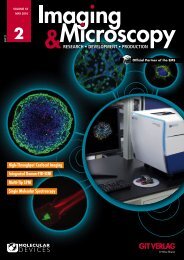SIM0216
Create successful ePaper yourself
Turn your PDF publications into a flip-book with our unique Google optimized e-Paper software.
ELECTRON MICROSCOPY<br />
Fig. 3: Stereographic SE image generated by tilting the beam by ±0.2° on a<br />
24 µm field of view of an ensemble of InGaN/GaN core-shell LEDs obtained<br />
with 10keV and at a sample tilt of 30°; one structure is contacted by a<br />
tungsten probe tip. The anaglyph can be viewed by red-cyan glasses.<br />
Fig. 2: (a) Spectra of CL and EL obtained by exciting small areas at the top<br />
part of the sidewall by a 590 pA electron beam of 10 keV and by driving a<br />
current of 1.5 µA from the probe tip contact to a buffer contact, respectively.<br />
(b) CL mapping of the InGaN MQW emission using a 500 nm short<br />
pass filter.<br />
emission (NBE) from the GaN<br />
outside the active region.<br />
Tilting the Electron Beam<br />
The electron optics (EO) of<br />
this FE-SEM is also capable of<br />
rocking the electron beam in a<br />
cone of up to ±12° for mapping<br />
of electron channeling patterns<br />
(ECP) on a small area of<br />
about 15 µm in diameter. Such<br />
ECP are also used to align the<br />
sample (via stage tilt and rotation)<br />
in specific diffraction<br />
conditions of the crystal struc-<br />
ture to evaluate the density of<br />
threading dislocations and its<br />
type by electron channeling<br />
contrast imaging (ECCI) [6]. By<br />
switching from the BSE detector<br />
to the mirror for light collection<br />
also a correlative analysis<br />
of ECCI with EBIC and CL<br />
can be performed at the same<br />
diffraction condition.<br />
This EO tilt can also be<br />
used to image the sample by<br />
the SEM from a certain direction<br />
without affecting the tip<br />
contact by stage movement.<br />
A subsequent scanning of the<br />
sample from different incident<br />
directions enables topography<br />
reconstruction and generates<br />
a three dimensional impression,<br />
e.g. by a stereographic<br />
image as given in figure 3.<br />
Beam Blanking for<br />
Electrical Measurements<br />
Beside in situ measurements<br />
the point contacts are used to<br />
obtain the IV-characteristics<br />
and also electroluminescence<br />
(EL) utilizing the CL-setup<br />
while blanking the electron<br />
beam (fig. 2). Care is given to<br />
arrange the probe tip for contacting<br />
in the position of the<br />
optical focus, neither touching<br />
nor significantly shadowing<br />
the mirror and sample.<br />
Due to lack of a contact layer<br />
the current is crowding locally<br />
at the contact [5].<br />
EL spectra evolve already<br />
at currents of a few nA locally<br />
driven through the point contacts<br />
on small InGaN/GaN LED<br />
structures. The MQW emission<br />
of EL is shifted compared<br />
to CL which is assigned to<br />
the different types of excitation<br />
and might also be related<br />
to an inhomogeneous MQW<br />
stack. No significant current<br />
spreading occurs along the<br />
p-type GaN shell as it has a<br />
lower conductivity than the<br />
n-type region; hence the EL<br />
is mainly originating from a<br />
small volume close to the contact.<br />
Subsequent contacting at<br />
different positions therefore<br />
gives a sub-µm spatial resolution<br />
of local electro-optical<br />
properties and the gradient of<br />
the InGaN composition along<br />
the sidewall facet can also be<br />
revealed by EL spectra [1,7,8].<br />
Acknowledgements<br />
The financial support of the<br />
MWK, DFG and BMBF is<br />
highly acknowledged.<br />
References<br />
All references are available<br />
online: http://bit.ly/IM-Ledig<br />
Affiliation<br />
Braunschweig University of<br />
Technology, Institute of Semiconductor<br />
Technology and<br />
Laboratory for Emerging Nanometrology,<br />
Braunschweig,<br />
Germany<br />
Contact<br />
Dipl.-Ing. Johannes Ledig<br />
Braunschweig University of Technology<br />
Institute of Semiconductor Technology,<br />
epitaxy competence center ec² and<br />
Laboratory for Emerging Nanometrology<br />
Braunschweig, Germany<br />
j.ledig@tu-braunschweig.de<br />
www.tu-braunschweig.de/iht<br />
Read more about microscopy<br />
of light emitting diodes:<br />
http://bit.ly/IM-LED<br />
Further information on<br />
cathodoluminescence microscopy:<br />
http://bit.ly/CL-SEM<br />
[1]<br />
All references:<br />
http://bit.ly/IM-Ledig<br />
46 • G.I.T. Imaging & Microscopy 2/2016



